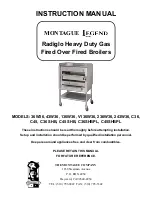
2 Safety information
Fire extinguishers
–
Austria: A 6 kg ABC powder extinguisher is spe-
cified as the minimum requirement. Install it out-
side the boiler room in an easily visible and
quickly accessible place.
–
Germany, Switzerland: In private homes, no fire
extinguisher is required for heating systems.
However, having a fire extinguisher is recommen-
ded.
Keep escape routes clear
–
Under staircases, on escape routes and in unfi-
nished attics, the installation of fireplaces is inad-
missible.
3.4 Chimney, flue gas pipe
Chimney cross-section and chimney height
The necessary cross-section depends on the nominal
output of the heating system and the effective chim-
ney height (at least 6.5 m). We recommend that you
have the calculations performed by an expert.
Chimney execution
–
The chimney must be resistant to moisture. Use
fire brick or stainless steel.
–
The chimney must conduct away the flue gases
reliably at all times.
Connect the chimney condensate drain to the
sewage system
–
Connect the condensate drain line of the chimney
to the domestic sewage system (to drain con-
densate, rainwater).
–
Use DN 25 diameter pipe, install siphon.
Provide each boiler with its own chimney
–
The boiler and the fireplace must be coordinated.
This is the only way to ensure the proper func-
tioning of the heating system and the correct
discharge of the flue gases.
–
If there is only one chimney available for two boi-
lers, there is a risk (considering the different ope-
rating states of the boilers - full load/partial load).
This can lead to problems (e.g. the flue gas has
too low energy during the ascent, and does not lift
off sufficiently from the chimney mouth, ...odour
pollution by flue gases).
–
Singly equipped chimneys are more reliable and
safer than multi-fuelled fireplaces.
Do not connect a gas boiler and blower boiler to
the same chimney
Do not connect a wood-burning stove and
blower boiler to the same chimney
–
A wood-burning stove typically requires a larger
chimney diameter than the blower boiler.
–
Acoustic disturbance from the blower boiler may
be possible in the living room (by the wood-
burning stove).
–
Unnecessary risk due to gas leakage, e.g. if the
blower boiler is defective.
Execution of the flue gas pipe
–
Run the flue gas pipe towards the chimney in
a short and rising direction, with as few chan-
ges of direction as possible.
–
Change direction in the form of aerodynamically
favourable arcs, do not build kinks.
–
The diameter of the flue gas pipe to the chimney
may be enlarged if required, but may not be redu-
ced.
–
Place the inlet of the flue gas pipe in the chimney
just below the ceiling.
–
The flue gas pipe must be tight. Seal seal-less
flue gas pipes on site with heat-resistant silicone.
Insulate flue gas pipe
–
Insulate the flue gas pipe continuously from the
boiler to the chimney.
–
Recommended insulation thickness: 50 mm rock
wool.
–
Serves to prevent temperature loss and prevents
the consequential formation of condensation.
6
Installation manual
ecotop-zero, ecotop-light







































